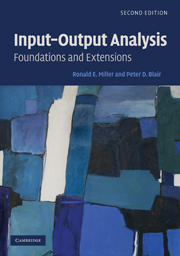Book contents
- Frontmatter
- Contents
- List of Figures
- List of Tables
- Preface
- 1 Introduction and Overview
- 2 Foundations of Input–Output Analysis
- 3 Input–Output Models at the Regional Level
- 4 Organization of Basic Data for Input–Output Models
- 5 The Commodity-by-Industry Approach in Input–Output Models
- 6 Multipliers in the Input–Output Model
- 7 Nonsurvey and Partial-Survey Methods: Fundamentals
- 8 Nonsurvey and Partial-Survey Methods: Extensions
- 9 Energy Input–Output Analysis
- 10 Environmental Input–Output Analysis
- 11 Social Accounting Matrices
- 12 Supply-Side Models, Linkages, and Important Coefficients
- 13 Structural Decomposition, Mixed and Dynamic Models
- 14 Additional Topics
- Appendix A Matrix Algebra for Input–Output Models
- Appendix B Reference Input–Output Tables for the United States (1919–2006)
- Appendix C Historical Notes on the Development of Leontief's Input–Output Analysis
- Author Index
- Subject Index
Appendix C - Historical Notes on the Development of Leontief's Input–Output Analysis
Published online by Cambridge University Press: 05 June 2012
- Frontmatter
- Contents
- List of Figures
- List of Tables
- Preface
- 1 Introduction and Overview
- 2 Foundations of Input–Output Analysis
- 3 Input–Output Models at the Regional Level
- 4 Organization of Basic Data for Input–Output Models
- 5 The Commodity-by-Industry Approach in Input–Output Models
- 6 Multipliers in the Input–Output Model
- 7 Nonsurvey and Partial-Survey Methods: Fundamentals
- 8 Nonsurvey and Partial-Survey Methods: Extensions
- 9 Energy Input–Output Analysis
- 10 Environmental Input–Output Analysis
- 11 Social Accounting Matrices
- 12 Supply-Side Models, Linkages, and Important Coefficients
- 13 Structural Decomposition, Mixed and Dynamic Models
- 14 Additional Topics
- Appendix A Matrix Algebra for Input–Output Models
- Appendix B Reference Input–Output Tables for the United States (1919–2006)
- Appendix C Historical Notes on the Development of Leontief's Input–Output Analysis
- Author Index
- Subject Index
Summary
Conceptual Foundations
The original idea of developing a detailed accounting of interindustry activity in an economy is certainly much older than Leontief's model. Leontief himself describes input–output as an analytical formalization of basic concepts set forth over a century and three quarters earlier by the French economist François Quesnay. Quesnay, in turn, was heavily influenced by earlier eighteenth century economists dating back to the beginning of that century. Perhaps the key precursor idea was the recognition of the concept of a “circular flow” of productive interdependences in an economy, which is a notion that can be traced to as far back as the early perspectives of Sir William Petty in the mid seventeenth century. We begin the story of input–output with this “pre-history.”
When British forces led by Oliver Cromwell invaded Ireland in the 1650s, Sir William Petty, a physician and Oxford professor of anatomy accompanying the British army, was assigned the task of assessing the spoils of war. In the history of economic thought Petty is often described as the first econometrician, since he portrayed his thinking as “political arithmetick,” although the term econometrics was not adopted until well into the twentieth century. Petty's account, documented in Petty (1690, 1691), described the characteristics of production, distribution, and disposal of the wealth of a nation as closely interconnected, and the problem of assessing the value of that wealth as properly reflecting the interrelationships among these characteristics. He also recommended in this work that “just accounts might be kept of the People, with the respective increases and decreases of them, their wealth and foreign trade,” which led to the first reported estimates of national economic accounts (Stone, 1973, p. 143).
- Type
- Chapter
- Information
- Input-Output AnalysisFoundations and Extensions, pp. 724 - 737Publisher: Cambridge University PressPrint publication year: 2009
- 1
- Cited by



